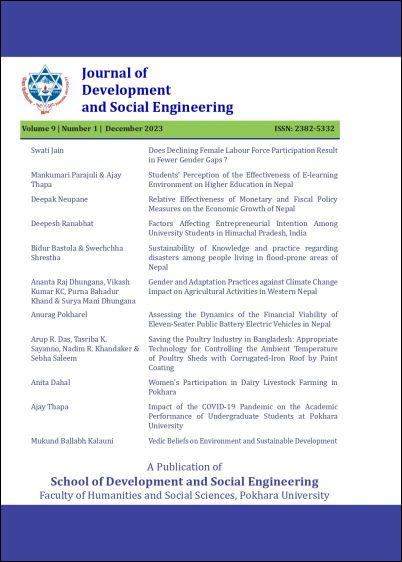Sustainability of Knowledge and practice regarding disasters among people living in flood-prone areas of Nepal
DOI:
https://doi.org/10.3126/jdse.v9i01.70605Keywords:
Disaster, sustainability, Household level plan, Disaster migration, flood prone areaAbstract
The main objective of this study is to examine the sustainability of knowledge and practice regarding disasters among people living in flood-prone areas of Nepal. Data for this survey were collected through a cross-sectional research design using a quantitative method. CARE Nepal and Handicap International implemented a community-based disaster risk reduction VISTAR project in Nepal’s Kailali, Dadeldhura, Kanchanpur, and Dang districts. The study used the baseline, end-line, and mainly post-project sustainability (PPS) survey data for detailed analysis. The study was conducted in four rural municipalities/municipalities of the Sudurpashchim Province. Univariate, Bivariate, and multivariate analyses (binary logistic regression) were applied to examine the sustainability of knowledge and practice regarding disasters among people living in flood prone areas of Nepal.
It was observed that slightly over two-thirds of the respondents (67.5%) were female, while nearly one-third (32.5%) of them were male. More than one-fourth (27.5%) of the respondents were from the 25-34 age group, followed by one-fourth (25.1%) from the 35-44 age group. Knowledge of various types of disasters had increased for all types in the end-line (24.5 in the baseline to 32.9 in the end line) and showed sustainability in the PPS study (44.08) on average. Only less than a fourth (24%) of respondents reported the Household (HH) level plan requirement to mitigate the effect of disaster. Multivariate analysis found that respondents whose caste/ethnicity was Dalit (aOR= 1.3, 95% CI=0.7 2.23) and Janjati (aOR= 1.37, 95% CI=0.7 – 2.67) were more likely to know about the requirement of the HH level plan to mitigate the effect of a disaster than Brahmin/Chettri. Likewise, respondents whose primary source of income was small business/service were 3 times (aOR= 3.58, 95% CI= 1.46- 8.81) more likely to know about the requirement of the HH level plan to, mitigate the effect of a disaster than those whose source of income was agriculture. Knowledge of the type of disaster and the need for a household-level plan to mitigate disaster is very low. Thus, programs that advocate the importance of following disaster mitigation measures at the community and household level should be targeted to motivate people to be self-equipped to tackle possible disaster incidents.
Downloads
Downloads
Published
How to Cite
Issue
Section
License
Copyright © Journal of Development and Social Engineering, School of Development and Social Engineering, Faculty of Humanities and Social Sciences, Pokhara University. All rights reserved. The School of Development and Social Engineering, Pokhara University holds the exclusive copyright of all the contents of this journal. No part of this journal may be reproduced or transmitted by any media or publishing organizations including websites without the written permission of the copyright holder. The contents of this journal are available for any citation, using a recognized and proper referencing system.




